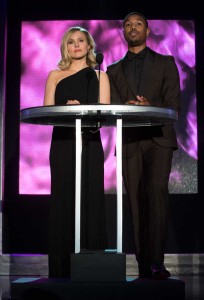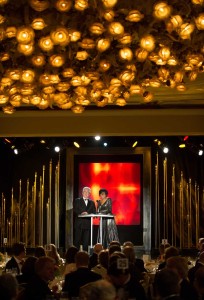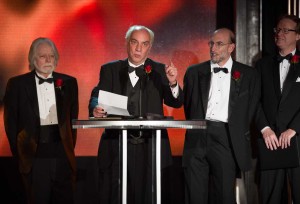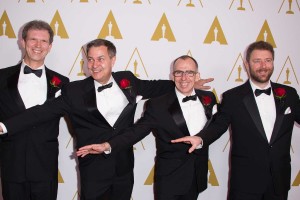![]()

Actors Kristen Bell and Michael B. Jordan took to the stage to read off the names of the recipients and reasons for the award. But this year, the hosts seemed to have actually studied the names and categories in advance. In a telling sign that it wasn’t just me noticing this strange phenomenon, the rest of my table began making similar comments, all equally surprised and somewhat impressed.
Bell knocked it out of the park, introducing winners like Martin Hill, Jon Allitt and Nick McKenzie for the creation of the spherical harmonics-based efficient lighting system.

(Photo by Jordan Murph/©A.M.P.A.S.).
Our industry has often been ridiculed in the mainstream media for its seemingly endless set of awards shows, with celebrities giving awards to other celebrities. But I must point to the fact we are in a creative industry. You don’t see the good folks at IBEW hosting a gala for Best High Power Splice to Live Current above 50 Feet (and if they did, you know they would also split the award for height and power rating just like we do). Or the UAW bestowing Most Creative Seat-belt Retention System of 2013 on a most deserved engineer. You know why: it’s not that sexy.
Not sexy like Deep Composting – seriously, for us in the industry geekdom, this is extraordinary stuff and used everywhere. I guess that’s the point isn’t it? Camera stabilization was nothing more than a solution that was needed for shooting off of boats. How do we keep the camera stable? Well, they figured it out – just to solve a problem in shooting. That solution became the basis for all stabilization that followed.

There are four types of awards – certificate (on paper), a bronze plaque, miniature statuette and the full-on statue.
Why one recipient receives one versus another is something of a mystery, unless you get lucky enough to end up sitting next to a Sci-Tech Committee member at the hotel bar. Preferring to remain unnamed, he told me the calculus that goes into which type of award to bestow is complicated. (Given the fact it’s the Academy, was anybody surprised by that?)

So, Josh Pines’ two certificates doesn’t let him walk up to the chip window and cash in to get one bronze plaque. On the contrary, the Academy looks at each of his contributions individually.
The honorees at the Academy’s Scientific and Technical Achievement Awards were:
Technical Achievement Awards (Academy Certificates)
Olivier Maury, Ian Sachs and Dan Piponi for the creation of the ILM Plume system that simulates and renders fire, smoke and explosions for motion picture visual effects.
Ronald D. Henderson for the development of the FLUX gas simulation system.
Andrew Camenisch, David Cardwell and Tibor Madjar for the concept and design, and to Csaba Kohegyi and Imre Major for the implementation of the Mudbox software.
Martin Hill, Jon Allitt and Nick McKenzie for the creation of the spherical harmonics-based efficient lighting system at Weta Digital.
Florian Kainz, Jeffery Yost, Philip Hubbard and Jim Hourihan for the architecture and development of the Zeno application framework.
Peter Huang and Chris Perry for their architectural contributions to, and to Hans Rijpkema and Joe Mancewicz for the core engineering of, the Voodoo application framework.
Matt Pharr, Greg Humphreys and Pat Hanrahan for their formalization and reference implementation of the concepts behind physically based rendering, as shared in their book Physically Based Rendering.
Dr. Peter Hillman for the long-term development and continued advancement of innovative, robust and complete toolsets for deep compositing.
Colin Doncaster, Johannes Saam, Areito Echevarria, Janne Kontkanen and Chris Cooper for the development, prototyping and promotion of technologies and workflows for deep compositing.
Thomas Lokovic and Eric Veach for their influential research and publication of the fundamental concepts of deep shadowing technology.
Gifford Hooper and Philip George of HoverCam for the continuing development of the Helicam miniature helicopter camera system.
John Frazier, Chuck Gaspar and Clay Pinney for the design and development of the Pneumatic Car Flipper.
Joshua Pines, David Reisner, Lou Levinson, Curtis Clark, ASC, and David Register for the development of the American Society of Cinematographers Color Decision List technology.
Jeremy Selan for the development of the OpenColorIO color management framework.
Scientific and Engineering Awards (Academy Plaques)
Ofer Alon for the design and implementation of the ZBrush software tool for multi-resolution sculpting of digital models.
Eric Veach for his foundational research on efficient Monte Carlo path tracing for image synthesis.
Andre Gauthier, Benoit Sevigny, Yves Boudreault and Robert Lanciault for the design and implementation of the FiLMBOX software application.
Emmanuel Prevenaire, Jan Sperling, Etienne Brandt and Tony Postiau for their development of the Flying-Cam SARAH 3.0 system.
Academy Awards of Merit (Oscar Statuette)
To all those who built and operated film laboratories, for over a century of service to the motion picture industry.





